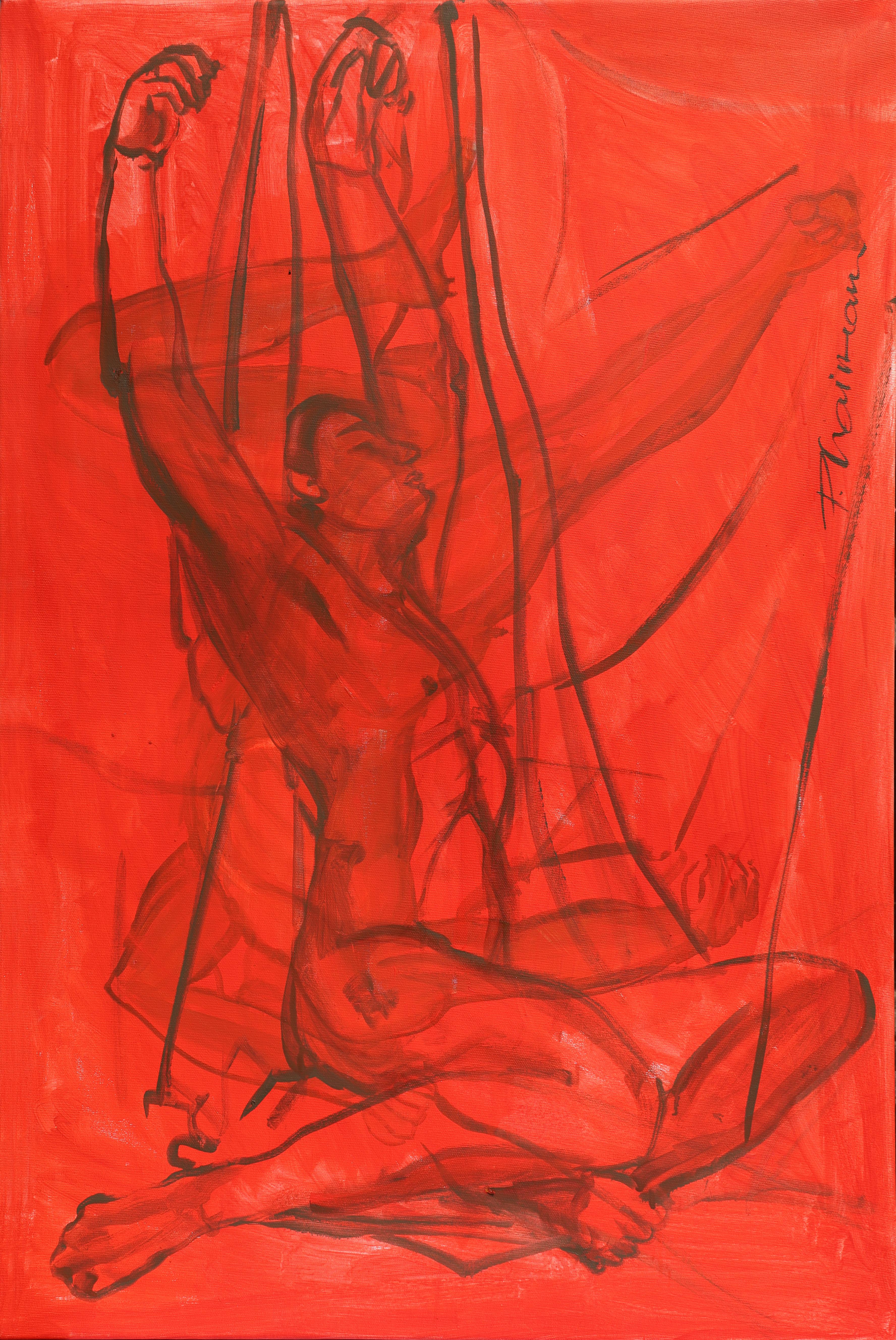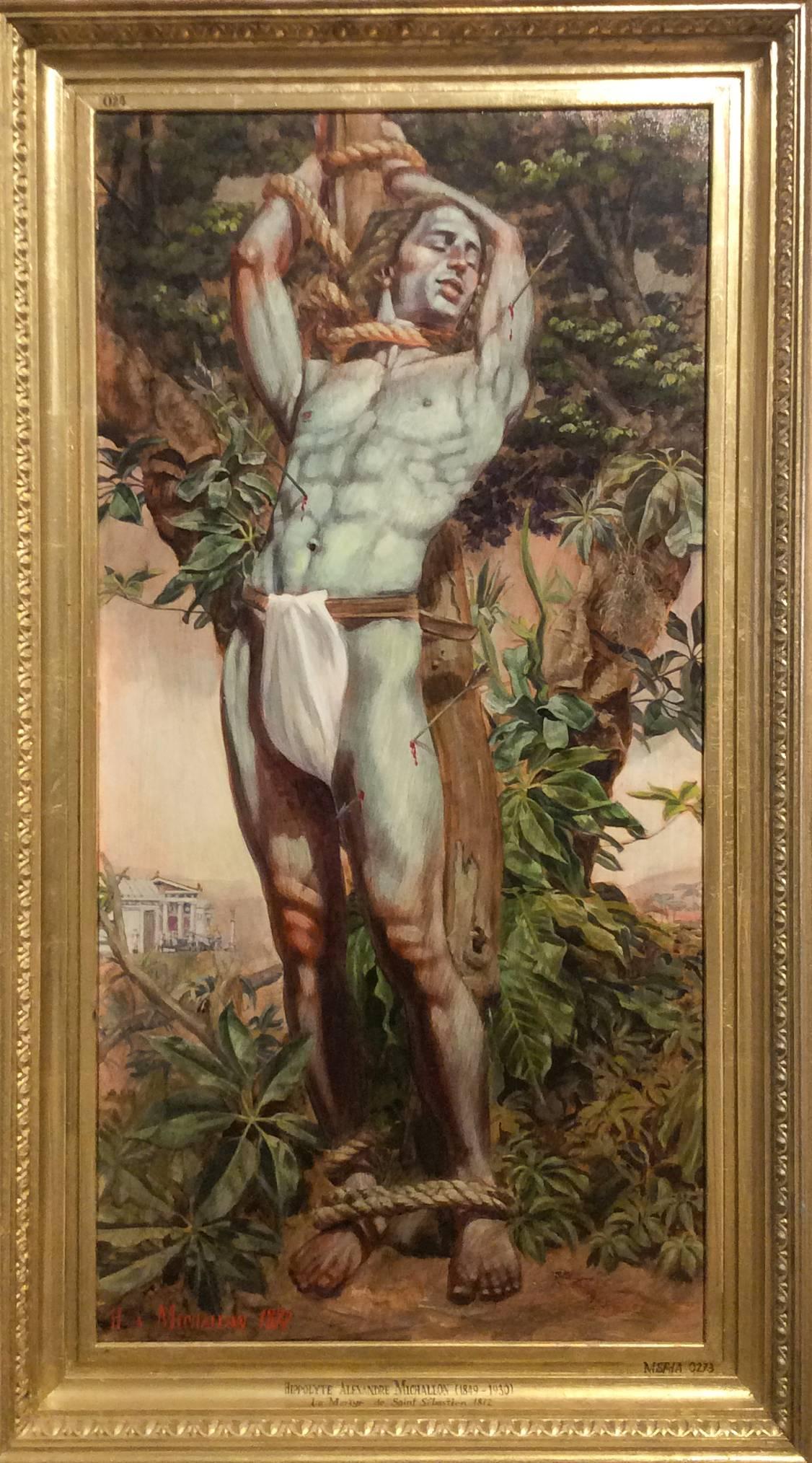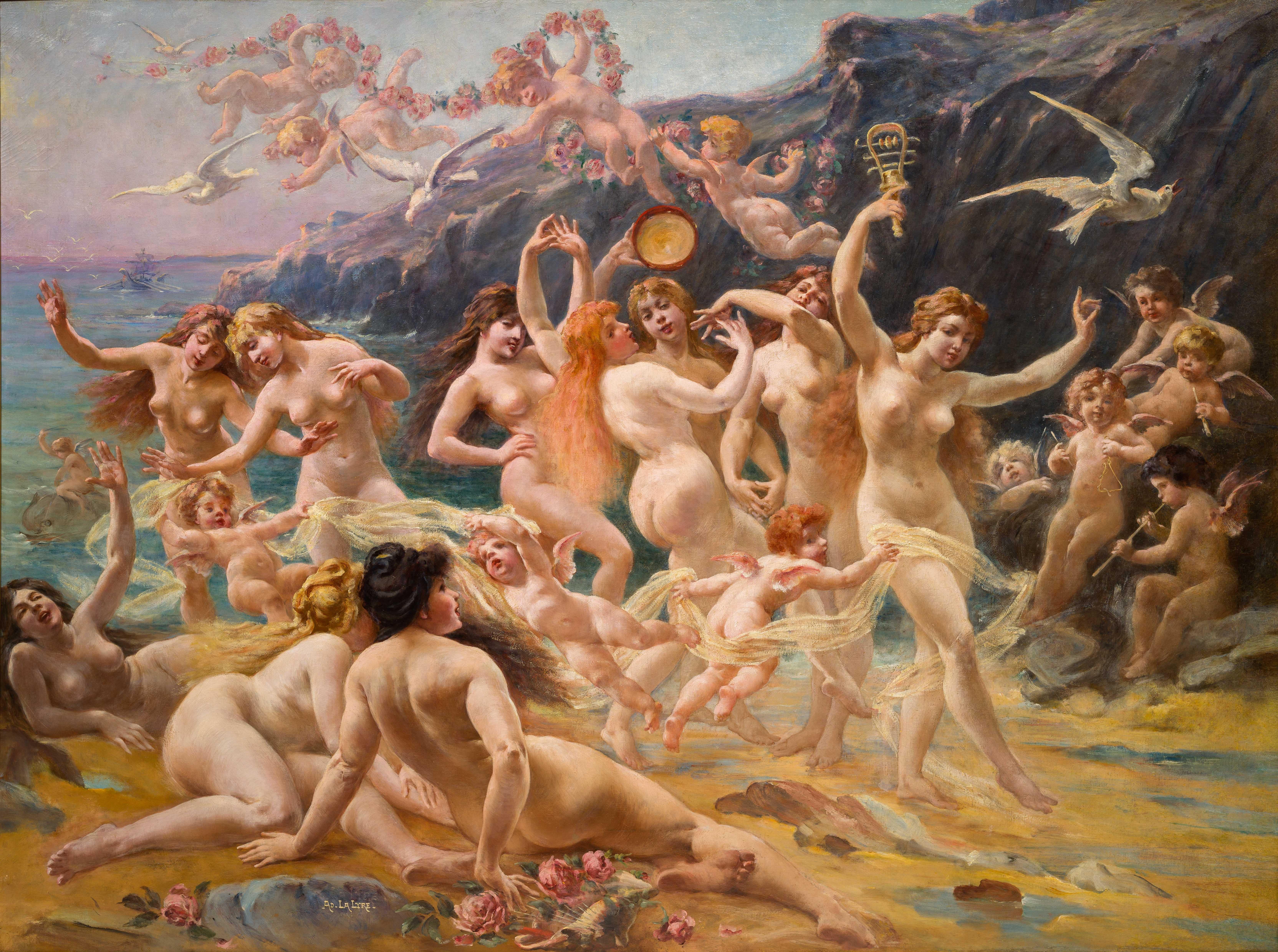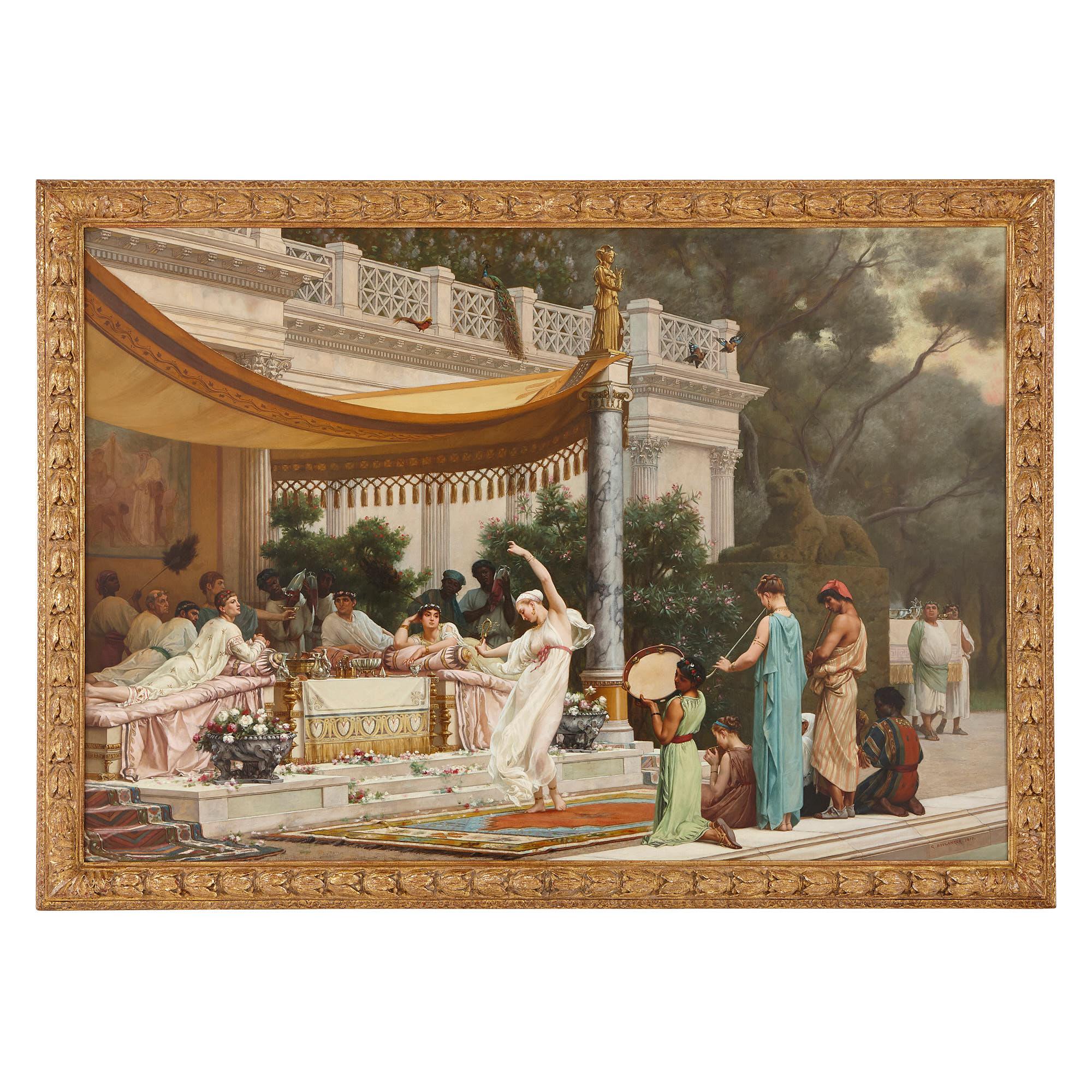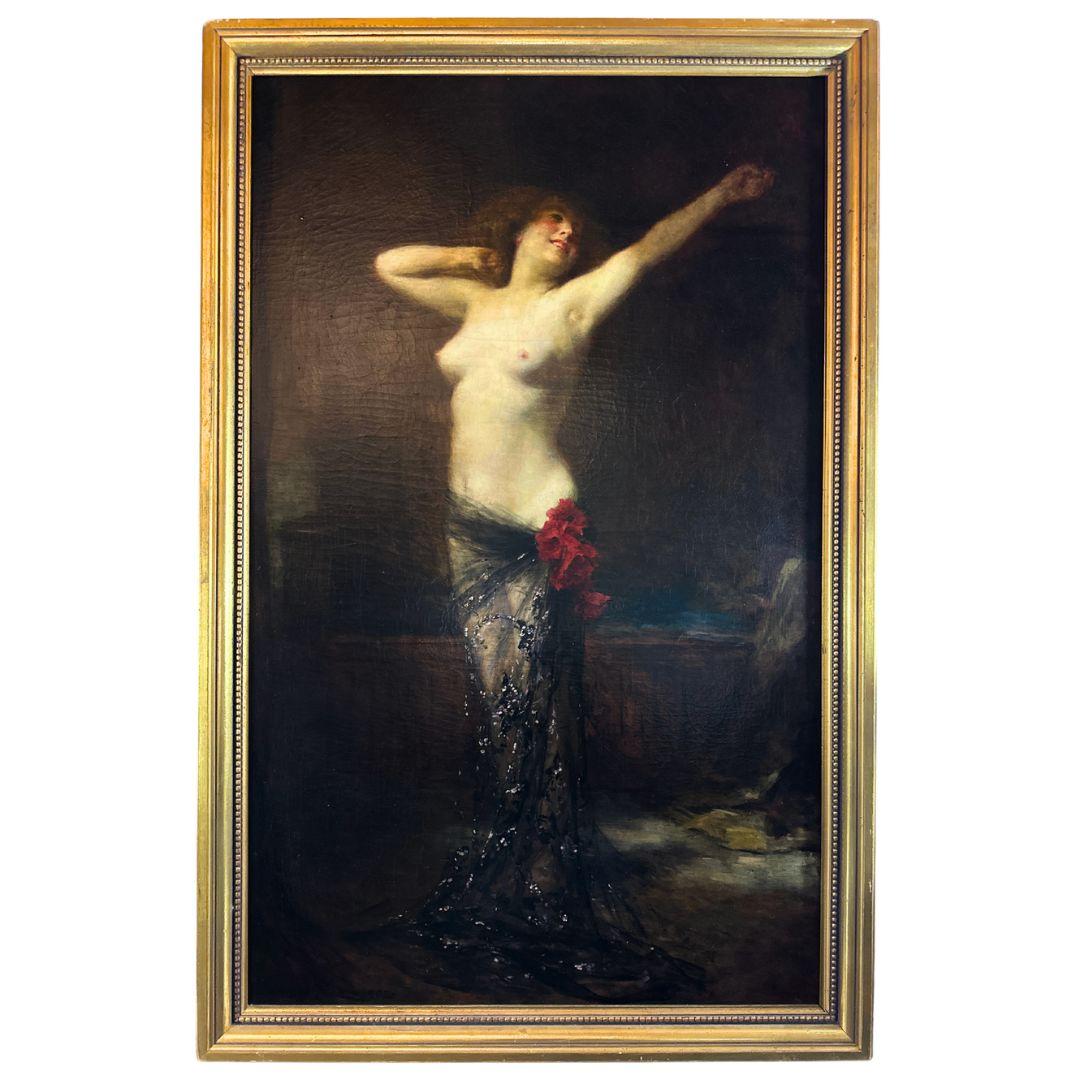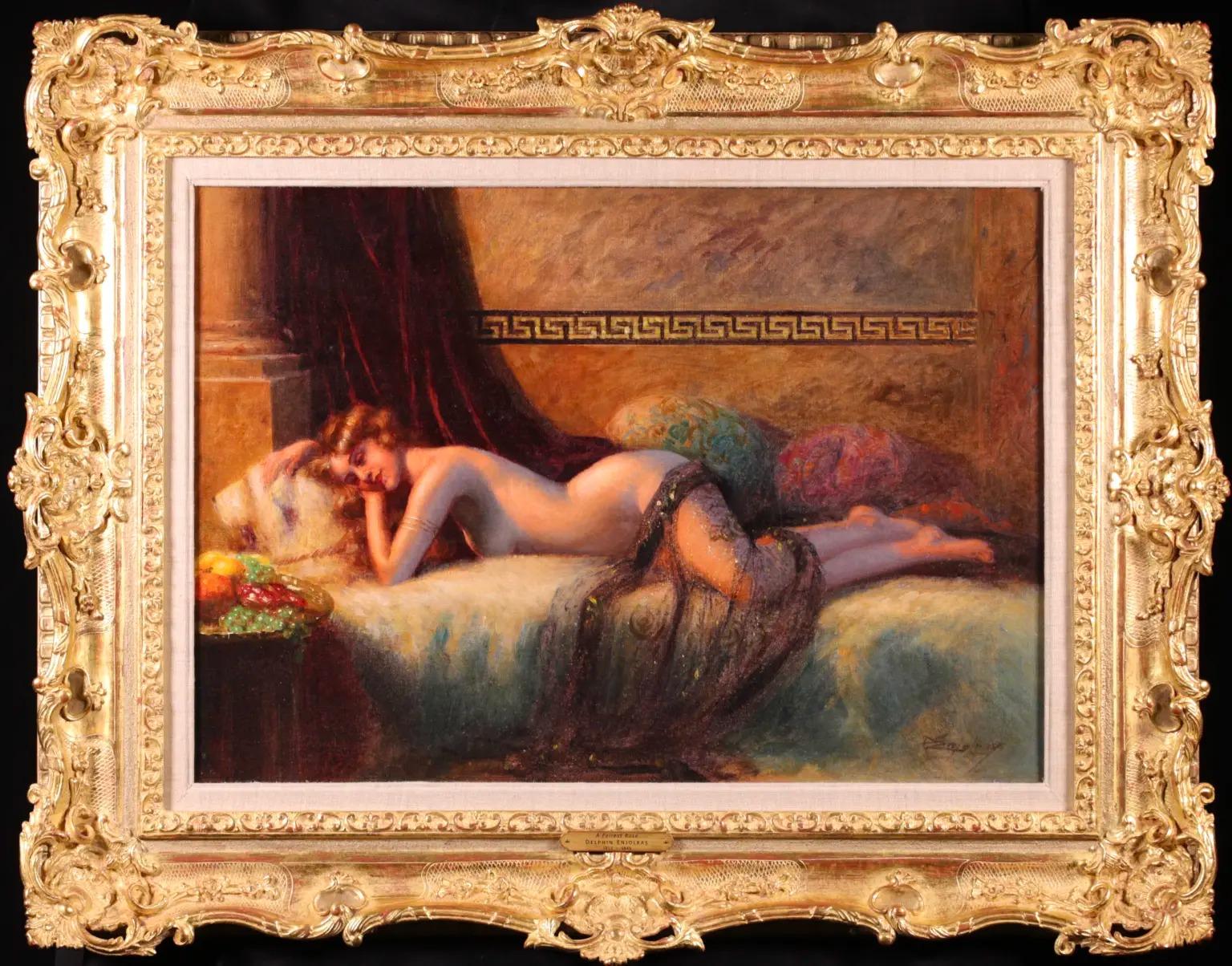Items Similar to Baigneuses (Bathers)
Want more images or videos?
Request additional images or videos from the seller
1 of 7
Louis-Joseph CourtatBaigneuses (Bathers)Dated 1885
Dated 1885
About the Item
French Academic painter Louis-Joseph Courtat displays his mastery of composition and the female form in this entrancing oil on canvas. Entitled Baigneuses, the work was painted for and exhibited at the 1885 Paris Salon, the foremost exhibition of painters in the Western world. Large in size, it captures two nude bathers within a tranquil beach scene. While the artist's skill for landscape painting is on display, it is his command of form, light and color that bring this canvas to life. The artist specialized in paintings that glorified the nude, and his skill is clear in the luminosity of his models' skin and the classical beauty of their form and proportions.
With their soft, undulating curves and flowing hair, Courtat's models reflect the two key influences on the young painter, that of the great Jean-Auguste-Dominique Ingres as well as his teacher Alexandre Cabanel. Like these two greats who came before him, Courtat similarly follows in the artistic tradition of the female nude that is traceable to classical antiquity and the Italian Renaissance.
Born in Paris in 1847, Courtat studied at the famed École des Beaux-Arts under Cabanel. He was one of the Academic master's first students at the school, where he began to teach in 1864. Displaying considerable skill at an early age, Courtat won the Prix de Rome around 1870, and subsequently studied in Rome for a number of years. He returned to Paris in 1873 to make his debut at the Salon, where he was met with immediate success, receiving a third class medal. He received medals again in 1874 and 1875, a remarkable achievement for a painter of his age. In addition to the monumental nudes he composed for the Salon, Courtat was also an accomplished portraitist and genre painter. Today his works are considered among the last great Academic paintings of the 19th century.
Dated 1885
Canvas: 70 1/2" high x 90 1/2" wide
Frame: 80" high x 99" wide
- Creator:Louis-Joseph Courtat (1840 - 1909, French)
- Creation Year:Dated 1885
- Dimensions:Height: 80 in (203.2 cm)Width: 99 in (251.46 cm)
- Medium:
- Movement & Style:
- Period:
- Condition:
- Gallery Location:New Orleans, LA
- Reference Number:
About the Seller
5.0
Vetted Seller
These experienced sellers undergo a comprehensive evaluation by our team of in-house experts.
Established in 1912
1stDibs seller since 2013
13 sales on 1stDibs
Typical response time: 3 hours
- ShippingRetrieving quote...Ships From: New Orleans, LA
- Return PolicyThis item cannot be returned.
More From This SellerView All
- The Education of Achilles by Auguste-Clément ChrétienBy Auguste-Clément ChrétienLocated in New Orleans, LAThe Education of Achilles by the Centaur Chiron Signed and dated "A.C. Chrétien 1861" (lower right) Oil on canvas A masterpiece of French N...Category
19th Century Academic Nude Paintings
MaterialsOil
- Italian Panel with Satyr and NymphsLocated in New Orleans, LAThis extraordinary Italian gouache and oil on canvas brings two of the most popular characters from Greek mythology vividly the life - the nymph and the satyr. Both creatures are famed for their carefree natures and lascivious temperaments, and tales abound of satyrs pursing nubile nymphs in order to rape or seduce them, usually with little success. One such narrative humorously unfolds in the present piece, which depicts an indignant satyr captured by three nymphs with a golden net. The relationship between these two mythological creatures was a popular one for artists throughout the 18th and 19th centuries, though its origins stretch back to antiquity. Both satyrs and nymphs...Category
Early 19th Century Other Art Style Figurative Paintings
MaterialsCanvas, Oil, Gouache
- Le carnaval du sage by René MagritteBy René MagritteLocated in New Orleans, LARené Magritte 1898-1967 Belgian Le carnaval du sage (The Sage’s Carnival) Signed “Magritte” (lower right); titled and dated "Le carnaval du sage 1947" (en verso) Oil on canvas The enigmatic paintings of René Magritte have become some of the most familiar and celebrated of the Surrealist movement. Among the most influential of the Surrealist painters of the 20th century, Magritte is an artist of international renown, as beloved for his popular appeal as he is for the psychological intensity of his works. The present oil on canvas, entitled Le carnaval du sage, was executed in 1947 at the height of his career, and it is a tour-de-force example of the haunting, mysterious scenes that comprise his oeuvre. Painted in the years following the Second World War, Le carnaval du sage showcases several recurring themes from Magritte’s oeuvre. Chiefly, a juxtaposition between the visible and the hidden is keenly felt. Throughout his career, Magritte explores the psychological obsession with revealing what is hidden, particularly with regard to the human face. In his Le fils de l’homme, he obscures the face of a man in a bowler hat with an apple, while his Les amants (Metropolitan Museum of Art) conceals the faces of two lovers with white sheets. In Le carnaval du sage, Magritte juxtaposes the blatant nudity of his central figure by masking her face, simultaneously revealing and concealing her from the viewer. The work also incorporates two of Magritte’s most common tropes – the glass of water and the baguette. Lending the scene a strange sense of domesticity, they appear infinitely familiar and distinctly out of place, and thus heighten the uncanny effect of Magritte’s composition. In the background hovers a ghost obscured by a sheet, a figure which was of particular fascination to Magritte beginning in 1946. He once wrote to his fellow Surrealist Paul Nougé: "I saw in a dream an answer to the problem of the ghost: the traditional ghost draped...Category
20th Century Post-Impressionist Nude Paintings
MaterialsCanvas, Oil
- Partial Coverage By Gil ElvgrenBy Gil ElvgrenLocated in New Orleans, LAGil Elvgren 1914-1980 American Partial Coverage Signed “Elvgren” (lower right) Oil on canvas The iconic illustrations of Gil Elvgren have become an irreplaceable facet of the American artistic landscape. Flirtatious beauties in light-hearted situations were the dominant subject matter for this intuitive artist, whose eloquent brush strokes dutifully captured the innocent sensuality of the mischievous girl next door. Partial Coverage, originally published in the 1956 Brown & Bigelow calendar, epitomizes the coquettish spirit of his beauties, whose nostalgic glamor give us a glimpse into a simpler time in American history. Elvgren is considered to be the greatest American pin-up and glamor artist. The majority of his work was done for the famed Brown & Bigelow, though at various points in his career he also worked for magazines such as The Saturday Evening Post and Good Housekeeping, as well as large corporations including Sealy Mattresses, General Electric and Coca-Cola. Born in St. Paul, Minnesota, Elvgren began his artistic education at the Minneapolis Art Institute, and later the American Academy of Art. His first job upon graduation was at the Chicago advertising firm of Stevens and Gross, working directly under Haddon Sundblom, famous for his Coca-Cola Santas. Elvgren would soon become his star pupil, contributing much to the Coca-Cola campaigns and eagerly learning techniques that he would carry into his famed pin-ups. After completing several special commissions with rave reviews, Elvgreen began doing pin-up work in 1937 for the Louis F. Dow Calendar Company, the biggest retailer of calendars of its day. Almost overnight, the artist became one of the most respected and successful commercial artists of his generation. More commissions followed, and, along with his work for Dow, Elvgren found himself booked solid at least one year ahead of his output. It was in 1944 that Brown & Bigelow approached him with an offer for a staff position. From that point on, for the next 30 years, Elvgren enjoyed tremendous commercial success unlike any other American artist of his day. Circa 1956 Canvas: 30 1/8“ high x 24 1/8” wide Frame: 33 3/4“ high x 27 7/8” wide x 1 1/2“ deep Literature: Charles G. Martignette and Louis K...Category
20th Century Figurative Paintings
MaterialsCanvas, Oil
- OndineBy Pierre Marcel-BéronneauLocated in New Orleans, LAMystical and mysterious, a mythological Ondine rests beside an ethereal forest pond in this majestic, original oil on canvas by French Symbolist Pierre-Amédée Marcel-Béronneau. A stu...Category
20th Century Symbolist Nude Paintings
MaterialsCanvas, Oil
- Après le bain (After the bath)By Pierre Auguste RenoirLocated in New Orleans, LAFor Pierre-Auguste Renoir, Impressionism's pre-eminent figure painter, depicting the nude was an exercise in bringing the canvas to life. He once said, “I look at a nude, I see myriads of minuscule shades. I have to find those which will make the flesh on my canvas come to life and resonate.” This compelling portrait by Renoir entitled Après le bain presents the nude figure of a woman in a serene, private moment, absorbed in the task of drying herself after a bath. The artist’s mastery of light and shading is incredible, achieving a sense of vitality in this otherwise ordinary scene. Renoir is celebrated for his figural work, especially his Rubenesque female nudes, however, it was not until the artist was in his forties that he depicted the nude with any frequency. In 1881, Renoir traveled to Italy, where he studied the works of the Renaissance masters and the ancient art of Pompeii and Rome. Upon his return to France, the nude became his favored subject, and he used the motif to combine the spontaneity of Impressionism with the solid modeling of classical painting. Renoir’s medium here, sanguine, a reddish-brown chalk, was used extensively in the Renaissance by Leonardo (who employed it in his sketches for the Last Supper), Michelangelo and Raphael. Its warm hue lends itself well to depicting flesh, and the chalk drawing allows for a greater focus on line, form and texture in a departure from the aspects of color and light that so often preoccupied the Impressionists. Après le bain conveys the impression of arrested motion with perfect naturalness, deftly capturing the moment before the elegant lines of the sitter's form change position. The sitter is almost certainly Gabrielle Renard, the nanny to Renoir’s children and a frequent model for the artist. Gabrielle was the cousin of Renoir’s wife, Aline, and came to Montmartre to work for the family at the age of 16. She developed a strong bond with the family and became a favorite subject for Renoir, appearing in several of his most important works, including his 1911 Gabrielle with a Rose (Musée d'Orsay). When Renoir began to suffer from severe rheumatoid arthritis that would eventually leave him unable to walk and scarcely able to grasp a paintbrush, it was Gabrielle that would assist the artist by positioning the paintbrush between his crippled fingers. Born in Limoges, France in 1841, Renoir began his career as an apprentice to a painter of porcelain wares. He later moved to Paris at the age of 21, enrolling at the prestigious École des Beaux-Arts. It was here, while studying under Charles Gleyre, that Renoir attained a tremendous appreciation for the academic style of painting, a quality that would last throughout his career. This was also when he met Claude Monet and several other classmates, with whom he would later form the Impressionists. Working closely with Monet, Renoir began experimenting with the portrayal of light and its effect on his canvases. The youngest member of the Impressionist movement, an astute Renoir recognized how a subject was constantly changing due to the dynamic effects of light on color. Relying heavily upon his academic training that focused on composition, lines and descriptive details, Renoir distinguished himself among his contemporaries. His intuitive use of color and expansive brushstroke, along with acute attention to his subject, have placed him among the finest painters in history. This work is accompanied by a certificate of authenticity and will be included in the forthcoming catalogue raisonné of the work of Pierre-Auguste Renoir from the Wildenstein Plattner Institute. Circa 1898 Canvas: 43 1/2" high x 35 1/2" wide Frame: 57 3/4" high x 49 1/4" wide Provenance: Galerie Durand-Ruel, Paris (acquired from the artist on January 25, 1899) J. Pereire Collection, France (1966) Sam Salz, New York (before 1981) Claus Virch, Paris French Compagny, Inc., New York Larry Silverstein, New York (circa January 1987) Le Clos de Sierne Gallery, Geneva Galerie Heyram, Paris (October 1987) Francis Gross M.S. Rau, New Orleans Literature: B. Schneider, Renoir, Berlin, 1957, p. 95 (illustrated in color, p. 83) M. Gauthier, Renoir, Paris, 1958, p. 83 (illustrated in color; erroneously dated '1916' and titled 'Woman in her toilet') F. Fosca, Renoir, L'homme et son obra, Paris, 1961, p. 280 (illustrated, p. 95; erroneously dated 'about 1890' and titled 'After the Bath...Category
19th Century Impressionist Nude Paintings
MaterialsCanvas, Paper, Chalk
You May Also Like
- Composition with Two Male Nudes - painting Paula Craioveanu oil on canvasBy Paula CraioveanuLocated in Forest Hills, NY"Composition with Two Male Nudes", oil and silver leaf on canvas, 35.5x23.5in / 90x60cm Part of my Male Nude series. Shipped as it is, stretched, directly from the artist's studio.Category
2010s Academic Figurative Paintings
MaterialsCanvas, Oil
- Le Martyr de Saint Sebastian (Academic Figurative Oil Painting in Gold Frame)By Mark BeardLocated in Hudson, NYAcademic style figurative oil painting on canvas 48 x 24 inches unframed 58 x 32 x 3 inches in gold leaf wood frame This vertical, contemporary figurative painting of Le Martyr de Saint Sebastian was made by Mark Beard under his fictitious artistic persona, Hippolyte-Alexandre Michallon. Painted in a modern Academic style, Beard paints this Christian saint with dramatic detail and emotional gravity. The scene is a common artistic depiction of Sebastian who according to traditional belief, was killed during the Roman emperor Diocletian's persecution of the Christians. Here the artist depicts a nearly nude Saint Sebastian standing stoically while tied to a rustic brown post. A lush green forested terrain decorates the background while a white neo-classical building sits in the distance, which is perhaps the tomb where Saint Sebastian's remains were laid to rest. Saint Sebastian's pale blue-grey, stone-like stone tone is characteristic of Mark Beard's work who often portrays muscular young men similarly to Greek statues. The vertical Academic style figurative oil painting is complimented with a vintage style gold leaf wood frame. The painting is signed 'H. A. Michallon 1872' in red oil paint in the lower right corner. The gold frame is also signed and inscribed with black oil paint in several places (please see images). Mark Beard is a contemporary artist who made this work under the pseudonym Hippolyte A. Michallon who painted during the late 1800's so slight wear (see images) is intentionally staged to align with the factitious artist's purposed history. About the artist: Mark Beard is perhaps the most literal example of an artist pulled in so many different directions that he chose to “invent” six different personae in which to channel his overflowing energy and need for expression. Each painting style is radically different from the next, so it remains entirely believable that the work could stem from six completely different people of different time periods and different schools of thought. With a background in set design, Beard has always been one who could conjure total magic with anything available. Mark Beard has exhibited with Carrie Haddad Gallery for nearly twenty years and there has never been a dull moment. Mark Beard, born in 1956 in Salt Lake city, now lives in New York City. His works are in museum collections worldwide, including the Metropolitan Museum of Art, New York City; the Museum of Modern Art, New York City; the Whitney Museum of American Art, New York City; the Boston Museum of Fine Arts; and the Harvard, Yale, and Princeton University Art Museums; among many others. We would not be the least bit surprised to see new ‘personas’ emerge in the coming years. About: Hippolyte - Alexandre Michallon, 1849 -1930 The long and peripatetic artistic career of Hippolyte-Alexandre Michallon began in a conventional fashion. The only son of prosperous bourgeois parents in Tours, he first studied drawing with his mother, an accomplished amateur painter of insects. His father, an undertaker who appreciated his son's talent and supported his ambition to become a painter, sent him to Paris at age sixteen to enroll in the studio of Francois-Edouard Picot (1786-1868), an eminent history painter and professor at the Ecole des Beaux-Arts, with whom he studied for three years, until Picot's death. Under his aging teacher's guidance and tutelage, Michallon entered the preliminary stages of the Prix de Rome contest at the Ecole three times, winning an Honorable Mention in 1869 for his composition entitled The Solider of the Marathon. For the next twenty years Michallon regualarly exhibited paintings on historical and biblical themes at the Paris Salon, as well as commissioned portraits. By his own account, the most ambitious work of Michallon's career was a thirty-foot canvas depicting Noah's Ark, which he exhibited in the Salon in 1875. Michallon began painting atmospheric but zoologically correct images of exotic animals in the wild. These achieved a certain popularity among French and foreign collectors alike, providing Michallon with financial security for the first time in his career. Michallon moved to England in 1893. His outstanding technical skills easily earned him a position on the faculty of the Slade School of Art in 1900. The craze for animal paintings proved short-lived. He continued to teach at Slade for the next two decades, but his classes gradually dwindled in size as the academic approach and methods he espoused went from outmoded to downright unpopular. Finally in 1922, finding himself reduced to a single pupil, the talented young American Bruce Sargeant, he retired from Slade, persuading Sargeant to leave with him and undergo private instruction at home. Several years later he retired to a cottage at St. Ives, Cornwall, where he lived quietly until his death in 1930, forgotten by all but a few former students, among them Edith Thayer Cromwell...Category
Early 2000s Academic Figurative Paintings
MaterialsCanvas, Oil
- La Danse des SirènesBy Adolphe LalyreLocated in Paris, FRAdolphe LA LYRE 1850-1935 French "La danse des Sirènes" Oil on canvas Signed and dated lower left Painted in 1909 Canvas: 59" high x 78 3/4" wide Frame: 64"high x 84 5/8" wide ...Category
Early 20th Century Academic Nude Paintings
MaterialsCanvas, Oil
- 'A Summer Repast at the House of Lucullus', large oil painting by BoulangerBy Gustave Clarence Rodolphe BoulangerLocated in London, GBThis beautiful painting was created in 1877 by the well-known French painter, Gustave Clarence Rodolphe Boulanger. Boulanger often produced work which combined the classical and Orie...Category
Late 19th Century Academic Figurative Paintings
MaterialsCanvas, Oil
- The Dance 19th-century Large Antique Nude Oil Painting on Canvas, Signed & DatedLocated in Jacksonville, FLExhibited at the Paris Salon, exhibition label on reverse. Description: Édouard François Zier (1837-1924) was a French painter known for his captiva...Category
Early 19th Century Academic Nude Paintings
MaterialsCanvas, Oil
- Fairest Rose - French Academic Nude Oil Painting by Delphin EnjolrasBy Delphin EnjolrasLocated in Marlow, BuckinghamshireSigned nude in interior oil on canvas circa 1900 by French academic painter Delphin Enjolras. The piece depicts a red-haired nude resting on a bed in a lush boudoir with a sheer scar...Category
Early 20th Century Academic Nude Paintings
MaterialsCanvas, Oil
